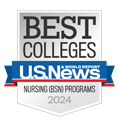Dr. Larson Presents at American Thoracic Society Conference
Research regarding patients with chronic obstructive pulmonary disease finds link between confidence-building programs and positive outcomes.
ATS 2011, DENVER – Janet Larson, PhD — chair of the University of Michigan School of Nursing’s Division of Acute, Critical, and Long-term Care — presented new research regarding the promotion of healthy exercise in the lives of patients with chronic obstructive pulmonary disease (COPD) at the American Thoracic Society (ATS) 2011 International Conference in Denver on May 17.
Patients with COPD often have significant breathing problems and lead sedentary lives with little daily physical activity. Pulmonary rehabilitation programs can help COPD patients increase physical activity and improve overall fitness; however, most rehabilitation programs focus on moderate-to-vigorous exercise routines rather than light routines, and few patients continue those exercises once rehabilitation ends.
Patients with COPD are more likely to increase physical activity on a day-to-day basis when exercise classes are combined with a confidence-building program, according to researchers from Michigan and Illinois. The study found, however, that those improvements are only short-term, and patients would return to their original levels of activity once the confidence-building program had ended.
“Recent evidence from other studies suggests that increasing physical activity and decreasing the amount of time spent in sedentary activities could have beneficial health effects that are separate from the effects of exercising, and we believe that increasing light physical activity may be a more realistic goal for people with health problems like COPD,” Dr. Larson said.
“Self-confidence-building programs, or self-efficacy-enhancing programs, have been widely used to promote adherence to exercise programs in the healthy population and they have had positive results in the short term, but long-term change in behavior is still challenging,” she added. “We wanted to see if these programs might help improve patients’ willingness to continue light physical activity once the exercise program ended.”
For their study, the researchers enrolled 49 people with COPD and divided them into three groups: patients who used upper-body resistance exercises in combination with the self-confidence-building program; patients who used upper-body resistance training and health education; and patients who used gentle armchair exercises plus health education. The self-confidence-building intervention included small-group activities administered for 15 minutes per week for four months and three supervised exercise sessions during the subsequent year to evaluate progress. The program focused on building self-confidence in three areas: upper-body strength training; the ability to sustain training after the end of the program; and being more active on a day-to-day basis. Patients trained in the laboratory twice a week and at home once a week for four months and were followed for 12 months after the end of structured training. During the study period, patients were monitored at least 10 hours a day.
“We measured physical activity with an accelerometer which is similar to the pedometers that people wear to measure their steps per day,” Dr. Larson noted.
They found COPD patients who participated in the self-confidence-building program increased their light physical activity, such as standing and walking slowly, immediately after the end of four months of training by an average of 20 minutes a day, but they did not sustain this improvement at one year after the training. There was no change in the time spent in sedentary activity and no change in the amount of time spent in moderate-to-vigorous physical activity.
“We worked with exercise psychologists to develop this program, and a similar program had been successfully used in healthy elderly people,” Dr. Larson said. “Based on previous research we expected that the self-confidence-building program would be the best way to increase physical activity.”
Dr. Larson said the next step in this research will be to strengthen the self-confidence-building program, emphasizing increases in light physical activity focusing on ways to sustain those increases over time.
“If these findings are extended and confirmed, it will influence the guidance and physical activity goals that we recommend for people with COPD,” Dr. Larson said. “Pulmonary rehabilitation programs will focus on increasing people’s self-confidence in their ability to increase their light physical activity in addition to encouraging people to increase moderate–to-vigorous physical activity. This is potentially important because it may be more realistic for COPD patients to increase light physical activity and outcomes may be more positive.”





